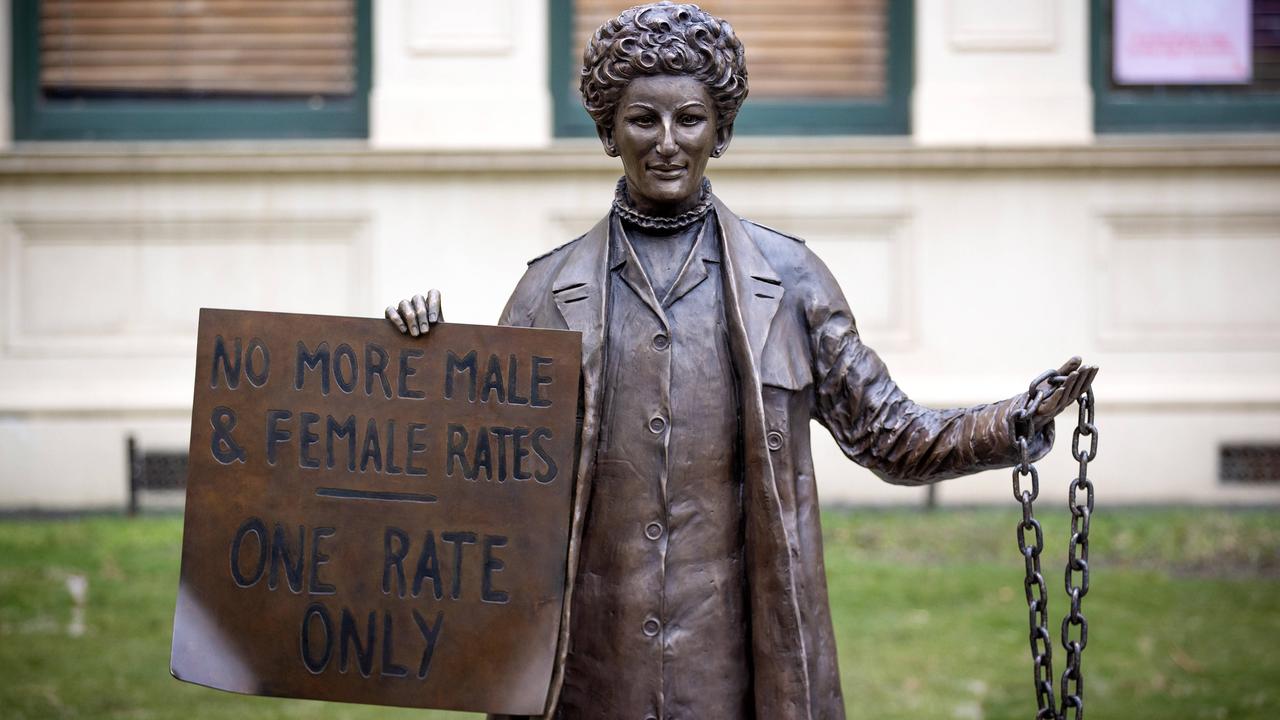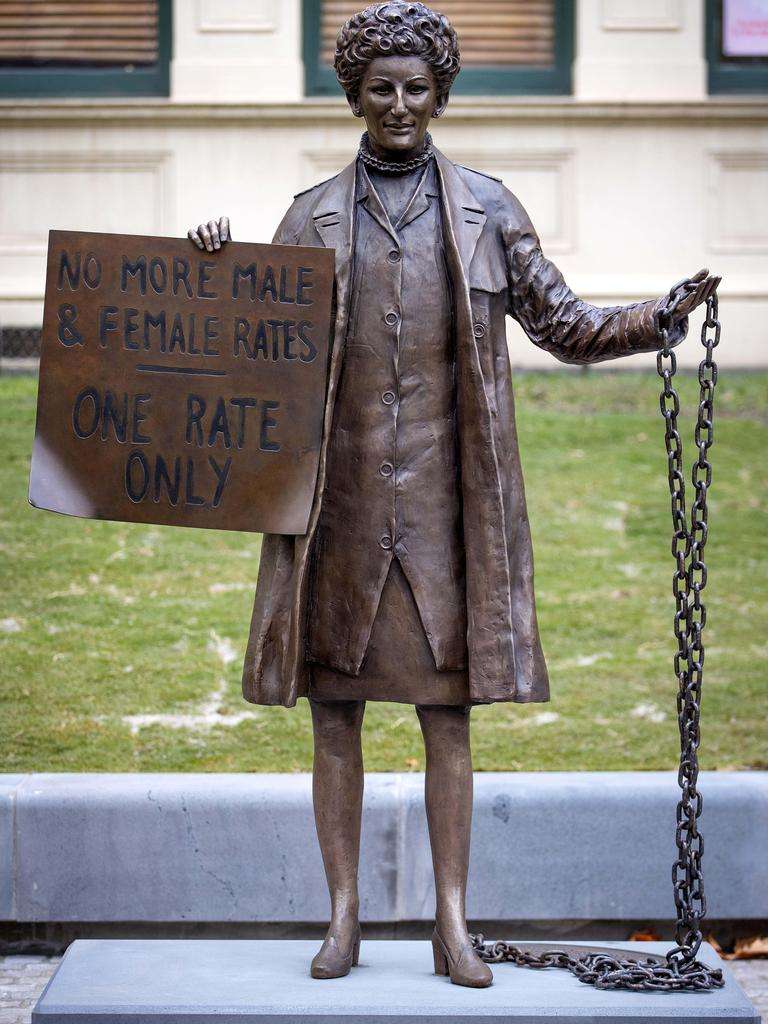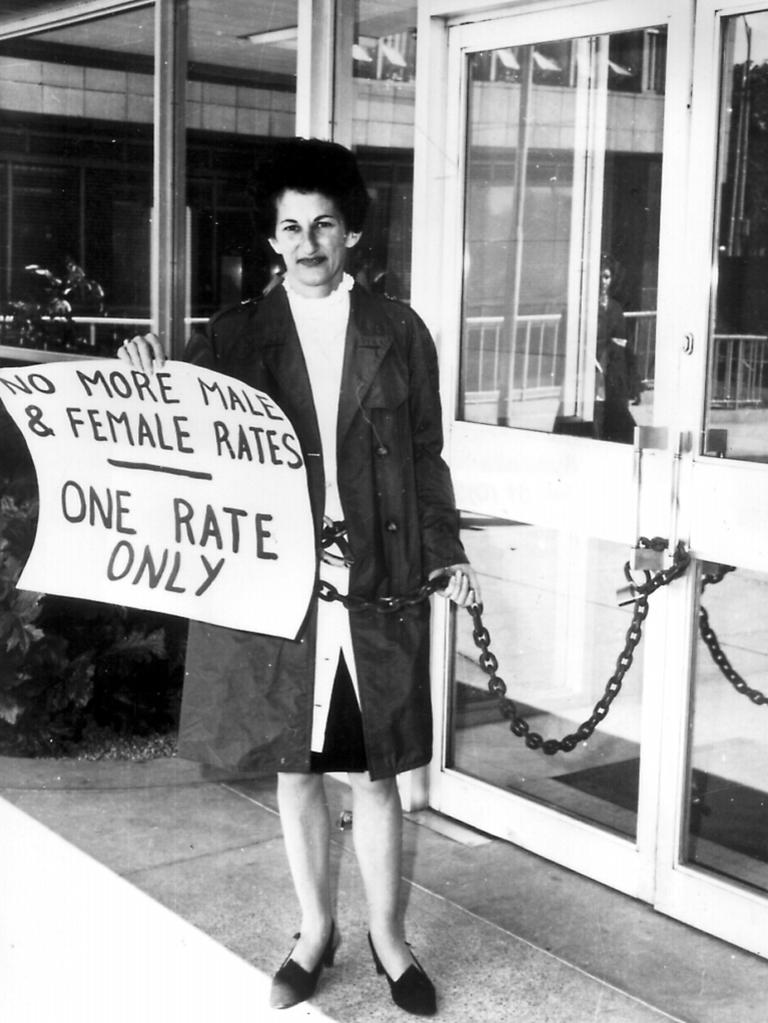Australia’s equal pay pioneer Zelda D’Aprano honoured with bronze statue
A new statue celebrates Australian housewife turned activist Zelda D’Aprano who fought for women to be paid the same as men

READING LEVEL: GREEN
An Australian woman who became a symbol of the struggle for equal pay* more than 50 years ago has been honoured* with a bronze statue.
Zelda D’Aprano is best known for chaining herself to the doors of the Commonwealth Building in Melbourne in 1969 to draw attention to her fight for equal wages for women — and it’s this moment that is captured in the statue created by artist Jennifer Mann.
Called ‘Chain Reaction’, the statue shows Mrs D’Aprano holding a chain and locks and a sign that reads: “No more male & female rates*. One rate only.”

Former Prime Minister Julia Gillard helped unveil the statue outside Victoria’s Trades Hall and hoped it would be “the first of many”.
“We need to be bold and loud about the achievements of Australian women … young women need role models they can identify with. They need that visual reminder that they, too, can achieve great things,” Ms Gillard said.

ZELDA D’APRANO’S STORY
Born in 1928 in Carlton, Mrs D’Aprano grew up in poverty during the Great Depression*. Her parents were European Jews who, both orphaned at a young age, sought a better life in Australia. Although she was a good student, she left school before she turned 14.
Mrs D’Aprano’s first job was in a factory putting jam onto biscuits, before working in sales and making clothes. She married at 17 and soon after give birth to a daughter. She then stayed home to look after her family.
As much as she loved motherhood, she felt isolated* and bored.
She heard about increases in gas and electricity prices and began asking other housewives to start a discussion group. This was the start of her public campaign for change.
After returning to full-time work as a dental nurse, she joined the union, which is a group to help solve workplace issues.
Almost immediately, Mrs D’Aprano began clashing with the all-male bosses over issues including the need for equal wages.

To highlight her point, she paid only 75 per cent of her fare when travelling on the tram to reflect the gender pay gap of 25 per cent, and protested against women being restricted to ladies’ lounges in pubs, where the drinks were more expensive.
When equal pay was discussed and rejected at a hearing in the Commonwealth Building, Mrs D’Aprano was frustrated by the lack of female voices.
“Here are all the women, here we are, all sitting here as if we haven’t got a brain in our bloody heads, as if we’re incapable of speaking for ourselves on how much we think we’re worth. And here are all these men arguing about how much we’re worth and all men are going to make the decision,” she said.
This inspired her to chain herself to the doors and it drew enormous attention to the equal pay campaign. She started the Women’s Action Committee to keep up the fight.

In 1972 the Commonwealth Conciliation* and Arbitration* Commission finally extended the equal pay concept to ‘equal pay for work of equal value’.
Mrs D’Aprano died in 2018, but those unveiling her statue say her fight is far from over.
Victorian Minister for Women Natalie Hutchins said: “This statue elevates Zelda’s legacy* as a pioneer* for gender equality* and equal pay, while reminding us there’s much more to be done to identify and dismantle the systems and structures which continue to drive inequality* for women.”

GLOSSARY
- equal pay: when everyone is paid the same for doing the exact same job
- honoured: to give special recognition
- rates: amounts
- Great Depression: in the 1930s, much of the world faced big money problems and many people were out of work, hungry, or homeless
- isolated: being alone
- conciliation: a quick and informal way to solve disputes
- arbitration: a method of settling disputes between individuals, groups, or countries
- legacy: the most important role you played in life to guide others
- pioneer: someone who leads the way to something new
- gender equality: when people of all genders have equal rights, responsibilities and opportunities
- inequality: when some people lack the rights, opportunities and fair laws of others
EXTRA READING
World’s first statue of female cricketer at SCG
Great Barrier Reef pioneer honoured
Tayla Harris ‘The Kick’ statue unveiled
QUICK QUIZ
- Why is the statue called ‘Chain Reaction’?
- What action started Mrs D’Aprano’s public campaigning?
- Why did she only pay 75 per cent of her tram fare?
- Why was she frustrated during the 1969 discussion about equal pay?
- Her statue is located outside which Melbourne building?
LISTEN TO THIS STORY
CLASSROOM ACTIVITIES
1. What makes a role model?
What makes Zelda D’Aprano a good role model for girls and women? Write a list of actions and her personal qualities that you think can be inspiring,
Time: allow 15 minutes to complete this activity
Curriculum Links: English; Personal and Social Capability; History
2. Extension
In the story, Julia Gillard says that she hopes that the statue of Zelda will be “the first of many”. Use your research skills to find out about other Australian women who have achieved "great things" or have made a difference. Choose one woman. Use the information that you have found to design a poster. The purpose of your poster is to convince others that the woman you have chosen deserves a statue, just like Zelda. You could include a design for the statue, a name and a suggestion for where the statue could be placed
Time: Allow 60 minutes for this activity
Curriculum Links: English; History; Civics and Citizenship
VCOP ACTIVITY
1. Conjunctions
Conjunctions are important in connecting ideas in a text and improving its flow. They help to join sentences, clauses or phrases to create a coherent and meaningful text.
Co-ordinating conjunctions are used to connect equal ideas or phrases — for example: and, but, or, so, yet, nor.
Subordinating conjunctions are connecting words or phrases that join a subordinating clause to the main idea. They provide additional information about the main idea — for example: because, although, while, when, if, since, until.
Complete these two activities below:
— Read the news article carefully and highlight all the co-ordinating conjunctions used in the text.
— Write down the subordinating conjunctions you found and the words or phrases they connect.

